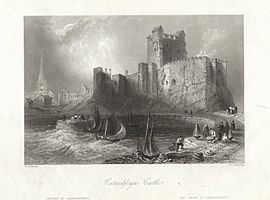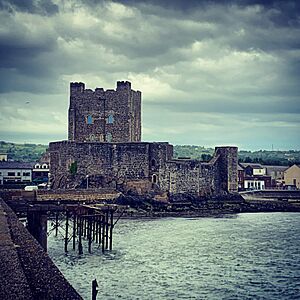Carrickfergus facts for kids
Quick facts for kids Carrickfergus
|
|
|---|---|
 Carrickfergus Castle at sunset |
|
| Population | 28,141 (2021 census) |
| • Belfast | 11 miles (18 km) |
| District |
|
| County | |
| Country | Northern Ireland |
| Sovereign state | United Kingdom |
| Post town | CARRICKFERGUS |
| Postcode district | BT38 |
| Dialling code | 028 93 |
| Police | Northern Ireland |
| Fire | Northern Ireland |
| Ambulance | Northern Ireland |
| EU Parliament | Northern Ireland |
| UK Parliament |
|
| NI Assembly |
|
Carrickfergus is a big town in County Antrim, Northern Ireland. Its name comes from the Irish words "Carraig Fhearghais," which means "Fergus' rock." It's located on the north shore of Belfast Lough, about 11 miles (18 km) from Belfast.
In 2021, about 28,141 people lived in Carrickfergus. It's the oldest town in County Antrim and one of the oldest in all of Ireland. The famous Carrickfergus Castle was built here in the late 1100s. For a long time, Carrickfergus was an important English outpost in Ulster. Today, it's part of the Mid and East Antrim District Council area.
Contents
History
Early Times
The town's name comes from Fergus Mór (Fergus the Great), a legendary king. A story says his ship hit a rock near the shore, and that rock became known as "Carraig Fhearghais" – Fergus' rock.
Carrickfergus is much older than Belfast. For a long time, it was bigger and more important than Belfast. Even Belfast Lough was called 'Carrickfergus Bay' until the 1600s.
The town became a settled place shortly after 1170. This was when an Anglo-Norman knight named John de Courcy came to Ulster. He made Carrickfergus his main base and built Carrickfergus Castle on "Fergus' rock" in 1177. The castle is the most famous landmark in Carrickfergus. It is known as one of the best-preserved Norman castles in Ireland.
Later, between 1203 and 1205, another important figure, Hugh de Lacy, took control of the town. He finished building the castle, adding its gatehouse and towers. He also started the nearby St Nicholas' Church. The town and castle were captured several times over the years by different groups.
Important Events
In 1597, the Battle of Carrickfergus happened during the Nine Years War. English forces fought against the Scottish MacDonnell clan. The English lost this battle.

Sir Arthur Chichester was put in charge of the castle and town in 1599. He helped bring English and Scottish people to live in the town. He also helped build the town wall.
In 1689, the castle was attacked by the forces of William of Orange. It held out for several days before giving up. William himself landed in Carrickfergus in 1690.
During the Seven Years' War in 1760, French troops briefly captured the town. They held it for a short time before leaving. In 1711, Carrickfergus was the place of the last witchcraft trial in Ireland. Eight women were found guilty, even though one of the judges thought they should be set free.
In 1778, during the American War of Independence, an American ship led by John Paul Jones tried to capture a British ship in Carrickfergus. They later fought in the North Channel, and the Americans won.
Modern Day
In 1912, thousands of people in Carrickfergus watched the famous RMS Titanic as it sailed up the lough for the first time. The ship stayed overnight near Carrickfergus before continuing its journey.
During World War II, Northern Ireland was an important military base for the United States. American soldiers trained here, including the first groups of the special US Rangers. There is a US Rangers Centre nearby that remembers this time.
In the 1970s, Carrickfergus became a big center for making textiles. Factories like ICI and Courtaulds opened here. In 1981, the Kilroot power station opened. It is the largest power station in Northern Ireland.
In 2011, the title of Baron Carrickfergus was given to Prince William on his wedding day. He visited the town with Catherine, Princess of Wales in 2022.
Carrickfergus in Song and Poetry
The town is the topic of a classic Irish folk song called "Carrickfergus". It's a translation of an old Irish song. It starts with the words, "I wish I was in Carrickfergus."
A Scottish Gaelic poet named Alasdair mac Mhaighstir Alasdair wrote a poem called Birlinn Chloinne Raghnaill. This poem describes a sea journey of a Highland war galley (a type of boat) from Scotland to Carrickfergus.
Demography
In March 2021, the 2021 census showed that 28,141 people lived in Carrickfergus.
- Most people (73.49%) were from a Protestant or other Christian background.
- About 8.55% were from a Roman Catholic Christian background.
- Many people said they had a British national identity (73.94%).
- Some said they had an Irish national identity (5.53%).
- And 37.32% said they had a Northern Irish national identity. People could choose more than one identity.
Transport
Carrickfergus has three railway stations: Carrickfergus railway station, Clipperstown railway station, and Downshire railway station. These stations have regular trains to Belfast and Larne. You can also connect to trains for Dublin and Derry~Londonderry from Belfast.
Schools and Education
There are several primary schools in Carrickfergus, including St Nicholas' Primary School.
Secondary schools in the area include Carrickfergus Grammar School, Carrickfergus Academy, and Ulidia Integrated College.
Sports
Carrickfergus has several sports clubs. These include the football clubs Carrick Rangers F.C. and Barn United FC.
The town also has the Carrickfergus Sailing Club and Carrickfergus Cricket Club.
Media
Carrickfergus FM is a local community radio station that broadcasts at certain times of the year.
Notable Residents
Many interesting people have lived in or come from Carrickfergus:
- Robert Adrain (1775–1843), a famous mathematician.
- Edward Bruce (c. 1280–1319), a High King of Ireland and brother of Robert the Bruce, King of Scots.
- Sir John de Courcy (1160–1219), the knight who built Carrickfergus Castle.
- Charlotte Riddell (1832), a writer from the Victorian period.
- Jonathan Swift, a famous poet and satirist, lived near the town.
- Seán Lester (1888–1959), who was the last Secretary General of the League of Nations.
- Louis MacNeice, a poet who spent his early childhood in Carrickfergus.
- Fit Finlay, a former WWE wrestler, grew up nearby.
- Niamh Kavanagh, an Irish singer who won Eurovision in 1993.
- Adrian McKinty, a novelist who sets his Sean Duffy books in Carrickfergus.
- Jackie Woodburne, an actress known for her role in the Australian TV show Neighbours.
Twin towns – sister cities
Carrickfergus is connected with these towns in other countries:
- Anderson, United States
- Danville, United States
- Jackson, United States
- Portsmouth, United States
- Ruda Śląska, Poland
Images for kids
-
The wall mural and replica pillory in the town centre
See also
 In Spanish: Carrickfergus para niños
In Spanish: Carrickfergus para niños









